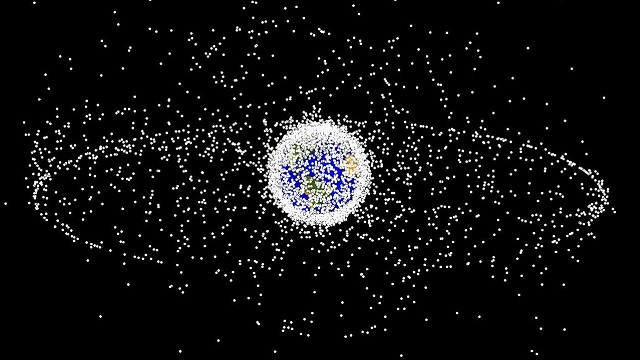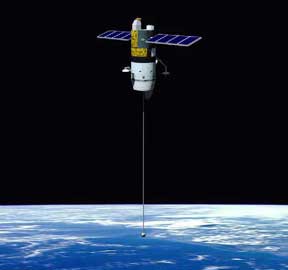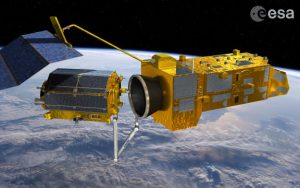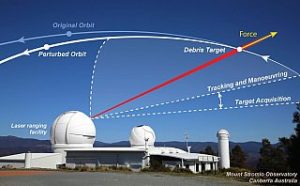For the past 60 years we’ve been littering in space, and scientists are warning it’s about time we did something about it before disaster strikes.
This article draws attention to the ever-increasing issue of space junk and details some proposed technological solutions. It is best suited to Year 5, 7 and 10 Earth and Space and Physics students learning about forces, the Solar System and human impact.
Word count: 1835

We humans are messy creatures. Waste management and disposal is a hugely expensive and important part of any developed nation’s infrastructure, and even then we have problems with littering and with harmful waste ending up in the environment.
But all around the globe humanity is facing a new waste management challenge. We have littered space with dead satellites, used rocket parts, and other debris from six decades of spaceflight, and things are about to get critical.
Paint flecks damage shuttle windows
In the 60 years since the launch of Sputnik, the first satellite, more than 6,800 spacecraft have been put into orbit around the Earth. Of those, about 2,400 are dead and unresponsive yet remain in orbit, silently and uncontrollably travelling around Earth.
Called orbital debris, they’re better known as space junk.
But old satellites are just the tip of the iceberg. There are also over a thousand spent rocket stages still in orbit, and thousands of pieces of mission-related detritus such as jettisoned covers and balance weights. It is starting to resemble a bit of a junkyard of unneeded stuff, stuck in orbit and left to go to waste.
But orbital debris can also occur accidentally. Equipment or bits of spacecraft can be jettisoned accidentally, including spatulas, tool bags and gloves, while explosions caused by faulty components, and collisions between spacecraft, can create thousands of extra pieces of debris from a single spacecraft.
Our best estimate is that there are around 600,000 pieces of debris between 1 cm and 10 cm in size, and potentially millions of smaller pieces such as flecks of paint. And while a paint fleck might not sound like much of a problem, at speeds of over 10 km per second, even these can cause large amounts of damage. The Space Shuttle’s windows were regularly damaged by microscopic pieces of debris such as this.
Low earth orbit could be inaccessible for generations
As more and more spacecraft are launched, and more and more orbital debris is created, we are rapidly reaching a crisis point. Space is big, but we are running out of room.
Space scientists and engineers fear that we will soon reach a tipping point where a collision between two spacecraft could set off a cascade of destruction in which the cloud of debris from one collision destroys more satellites, creating more debris leading to more destruction, and so on.
This scenario is called Kessler syndrome after the NASA scientist, Donald Kessler, who first proposed it – it was also portrayed in the film Gravity.
If such a runaway sequence of collisions were to happen, it would destroy most if not all satellites in low earth orbit and litter space with a cloud of destructive shrapnel, potentially making low earth orbit inaccessible for generations.
In a world that has come to rely on satellites for so much of our communication, science, and industry, the results would be catastrophic.
Today, space agencies, defence agencies, and other institutions use radar and telescopes to track as much of the orbital debris as they can. They predict its future orbital path and, if it is likely to be a hazard, manoeuvre other space craft out of danger.
This is becoming increasingly common for the International Space Station, and in the event of a Kessler syndrome scenario there could be no escape from the debris.
Now more than ever, we need to start taking action to manage and control orbital debris.
And so the great space clean-up begins
The first step is to create less debris in the first place.
For more than a decade all of the major space-capable nations have instituted debris reduction and mitigation measures. One of the key measures is to ensure that at the end of their operational lives, spacecraft are disposed of safely rather than allowed to wander uncontrolled in space.
Spacecraft in low earth orbit must have a system to de-orbit them to burn up in the atmosphere within 25 years of the end of their mission.
Spacecraft further out from Earth in geosynchronous orbit, where many communications satellites are stationed, must retain enough fuel to be moved to a “graveyard” orbit at the end of their mission.
Other debris-reduction strategies are employed in the design of the spacecraft and in the planning of missions. Rocket stages are no longer allowed to remain in orbit after launch.
Fairings, sensor covers, ballast, and other pieces normally ejected from the spacecraft after launch must be removed or modified to prevent them cluttering up the orbit. And spacecraft design should, wherever possible, be modified to reduce the risk of explosion, and remove materials, such as paint, that might create microscopic debris.
Despite these efforts to not create more junk, the debris already in orbit still poses a significant risk, so engineers are turning their attention to working out ways to actively clean up the low Earth orbit region.
Time to send garbage trucks into space?
One solution is to build a space tug, a spacecraft that would go up, catch defunct satellites and other debris, and either tow it to a different orbit or attach a small rocket to blast it elsewhere.
Catching old satellites also gives us the option to repair or refuel them in space and make them useful again, or even more ambitiously, use parts of old satellites to build new Franken-satellites while in orbit.
However, catching a spacecraft is extremely expensive. First, a whole new spacecraft needs to be built and launched to go after the old one.
Once in space, matching the orbits of the two spacecraft, and then changing the orbit of the target requires enormous amounts of fuel. With current systems, the cost of catching and de-orbiting a single satellite would likely run into the hundreds of millions of dollars.
To reduce the fuel requirements, one idea is to attach a long conductive tether to the target spacecraft. Like a massive rope dragging behind it, the tether would build up an electrical charge as it moved through the earth’s magnetic field, gradually slowing the target spacecraft down and dragging it out of orbit.

However, compared with the fuel required to launch and catch the target spacecraft, the actual difference in fuel use and cost would be minimal.
One complication with catching defunct spacecraft is that they can often be spinning out of control. Trying to catch a rapidly spinning spacecraft could seriously damage both craft and is just as likely to create more debris.
Clever capture systems are being designed to get around this problem.
Space dust is such a drag
Atmospheric drag is a problem for some spacecraft. Even hundreds of kilometres up, the thin upper atmosphere creates drag on the spacecraft and pulls it out of orbit.
For orbital debris removal this is a good thing. If we can bring the target spacecraft low enough the atmosphere will do half your work for you.
There are several ideas for exploiting or amplifying this effect.
One is to try to replicate atmospheric drag with man-made systems. A large volume of gas or dust would be launched into space and released in a target orbit, creating additional drag on all the spacecraft in that orbit.
Eventually that drag would bring them to a lower orbit where they will eventually burn up in the atmosphere.
As simple as this idea sounds however, dispersal of the dust or gas is a difficult problem. The dust or gas must stay together long enough to have the desired effect on the target spacecraft, but must disperse fast enough to not affect functioning, non-target, spacecraft going about their jobs.
Rather than using gas or dust, a similar idea is to use aerogel as a sort of catcher’s mitt. Aerogel is an extremely light weight, low density foam that is often said to resemble solid smoke.
The foam could be placed in front of the fast moving debris, capture it, and eventually drag it out of orbit. However, the same drag that would bring the satellite out of orbit also means just keeping the aerogel in orbit long enough to do its job properly becomes a challenge.
Even if dispersal and drag problems were solved, the huge volume and weight of gas, dust, or aerogel that would have to be launched to make a significant dent in our debris problem would be prohibitively expensive.
Shooting down debris with space lasers
One of the most sci-fi solutions could also be one of the most viable – use lasers to steer or shoot down the debris.
A large array of ground-based or space-based lasers could be trained on the target piece of debris, and fired to vaporise the surface of the side facing the lasers.
Rather than destroying the debris, the vaporised side would actually act like a weak rocket engine, pushing the debris to a new orbit, or de-orbit it completely.
However as straightforward as it sounds, vaporising bits of debris might lead to other problems. As small specks of material are blasted off the debris by the lasers, they would add to the volume of microscopic space junk already up there and, like the paint flecks, do a lot of damage to other spacecraft.
A spinning target also has its own complications. If the target is spinning fast enough, then the small thrust from the vaporisation will send the debris on the wrong course.
There are also some very Earth-based political concerns to this approach. One worry is whether high powered lasers designed for debris removal could also be used as weapons.
Space-based lasers are currently illegal because of international treaties banning weapons in space, while ground-based and airborne lasers raise concerns about arms control.
An alternative would be to reduce the power of the lasers and just use the pressure of the light to slowly nudge the debris. This requires only about one-thousandth of the power needed to vaporise bits of space junk, but it would greatly reduce how quickly the lasers could change the orbit of the debris.
Because of this, a low-power laser would not clean up space junk, but merely focus on slowly moving specific targets to safer orbits, while requiring stations around the world to work together to have a useful effect.
As the space junk would only be within range of one station for a few minutes, the stations would need to take it in turns to nudge a piece of junk, focusing on one piece while the other stations aim at other targets as they come in to view.
Slow and inefficient it may be, but politically more palatable.
Still in search of a final solution
With current technology, low-powered nudge lasers are the most practical and cost-effective way of dealing with space junk. However, even with an array of stations spanning the globe, the amount of cleaning they could do would be limited.
Far from being a final solution to the problem, it would buy us time to develop more effective technology to overcome the risks posed by our junkyard in space.
Login or Sign up for FREE to download a copy of the full teacher resource








